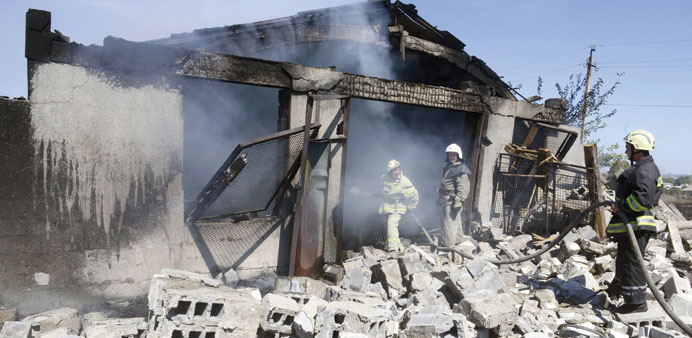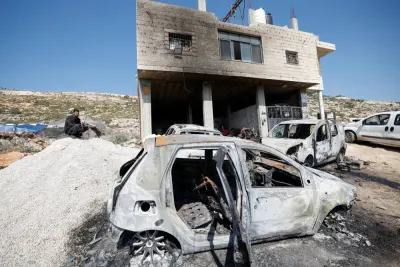AFP/Kiev/Donetsk
Rebels in east Ukraine yesterday appeared to have seized swathes of territory from government forces who abandoned vehicles and ammunition as they left, as Western intelligence said Russian army units were operating inside the country.
After weeks of successful military operations that have seen government forces push deep into the last rebel bastions, the tide appears to be turning once again in the four-month conflict, prompting a nervous government in Kiev to call on Nato for help.
AFP journalists saw no signs of government troops south of the rebel-held city of Donetsk, with road blocks on the entire 100km stretch to the Azov Sea manned by pro-Russia rebels.
Evidence of the hasty retreat emerged just hours after the first meeting in three months between President Petro Poroshenko and Russian counterpart Vladimir Putin which failed to achieve any concrete breakthrough.
There is increasing concern in Kiev over Russia’s willingness to intervene directly in the conflict with the Ukraine government claiming yesterday that a battalion of Russian soldiers had set up a military headquarters near the village of Pobeda, around 50km southeast of Donetsk.
Nato and Polish intelligence also have evidence of regular Russian army units operating in Ukraine, Poland’s Prime Minister Donald Tusk told his parliament yesterday.
Russian Foreign Minister Sergei Lavrov responded that the Kremlin was “not interested in breaking up” Ukraine, although it does respect two independence referendums from May - in Crimea and the Russian-speaking eastern regions of Lugansk and Donetsk.
Lavrov also confirmed that Russia will send a second aid convoy into Ukraine “in the nearest future” which will be followed by others. A first convoy was sent to Lugansk last week, and Kiev fears they could provide cover for smuggling military support to the rebels.
In the town of Starobesheve, about 30km southeast of Donetsk, there were signs of a hasty departure by Ukraine’s army. A Ukrainian tank sat parked on the roadside as villagers poked around cases of abandoned ammunition.
Rebels wearing the typical orange and brown ribbons on their fatigues manned positions throughout the town, which had remained relatively peaceful during the four-month conflict.
Locals told AFP that the troops left on Monday after shelling started from the direction of the Russian border about 30km away.
Ukraine’s military conceded that “militants together with Russian occupants” had taken control of Starobesheve, as well as a string of villages near Novoazovsk, a town on the Azov Sea where clashes had been raging for days.
Kiev said yesterday that 13 soldiers had died in the past 24 hours. AFP reporters saw the charred remains of three civilians whose car was hit by a shell in Donetsk, adding to another three civilians reported killed earlier in the day.
Poroshenko and Putin held marathon talks in the Belarus capital Minsk on Tuesday alongside top EU officials to try to find ways to end the conflict that has claimed over 2,200 lives.
The Ukrainian president said all sides had “without exception” agreed to his peace plan, and that he and Putin had discussed the “necessity of closing Ukraine’s borders” to prevent the movement of “equipment, mercenaries, and ammunition”.
Putin again insisted Russia had no role in the fighting, saying: “We cannot discuss any ceasefire conditions. It’s not our business, it’s Ukraine’s internal business.”
He played down reports that 10 Russian paratroopers had been captured 20km inside Ukrainian territory, backing his military’s claims that they had strayed across the border by accident.
Ukraine’s Prime Minister Arseniy Yatsenyuk said it was time for Nato to act when the alliance holds a summit in Wales next week. “We expect our Western partners and the alliance to provide practical help and take crucial decisions at the summit in September,” Yatsenyuk said.
Talks are also expected between Poroshenko and US President Barack Obama at the summit.
Russia vehemently opposes closer ties between Ukraine and Nato. Concerns that Kiev could be drawn closer into the Western security alliance are seen as the main motivation behind Russia’s actions in recent months, which have left it diplomatically isolated and facing increasing economic strain as a result of sanctions.
Nato chief Anders Fogh Rasmussen said in an interview published yesterday that the alliance was preparing a rapid response unit specifically designed to deploy troops swiftly in eastern Europe.
Rasmussen has repeatedly accused Russia of troop buildups on the border and said the unilateral convoy of aid send to the war-torn east last week was a “blatant breach” of Ukraine’s sovereignty.
“We will adopt what we call a readiness action plan with the aim to be able to act swiftly in this completely new security environment in Europe,” Rasmussen told the British daily Guardian.
“We have something already called the Nato response force, whose purpose is to be able to be deployed rapidly if needed. Now it’s our intention to develop what I would call a spearhead within that response force at very, very high readiness,” he said.
The move will not however include the creation of permanent bases in the flashpoint region, something eastern Nato members such as Poland and the Baltic nations have called for.
Rasmussen said that the temporary forces would stay “as long as necessary”.

Firefighters work to extinguish a fire after shelling by pro-Russia militants on the outskirts of Novoazovsk in the Donetsk region.


